My fist exposure to KRYPTOS was most likely when I seen it used in the TV Series Alias.
I most likely looked it up, got an idea of what it was about then forgot about it it for the next several years.
A few years ago I started working on the ciphers for Ghost in the wires where I have still only completed the ciphers for chapters 1 to 35 leaving the remaining 3 to finish, I’m still missing something about chapter 36. (any clues ?)
During that process I created several tools, one of them being a Quagmire 3 cipher tool and while searching for possible solutions for the Ghost in the wires ciphers I kept running across references to the Kryptos ciphers. Dropping the first two cipher into the Quagmire 3 cipher showed that they could be solved using that tool and the known keys.
If we look at Quagmire 3 it uses two keys and an indicator letter. If we test it with “A” we get this.
If we keep scrolling down the indicator letters and when we get to “K” we see this.
Or we can cheat and test all of them at the same time.
The question is, if we have some cipher text, plain text and the main key (KRYPTOS) can we figure out the Indicator key? And of course the answer is yes.
From the repeating pattern here we can guess what the keyword is.
In the process of creating this tool I discovered that the indicator letter was irrelevant to finding the indicator key. Given the way that Quagmire 3 works we can make a list of all 26 alphabets and compare if the index positions of the plain and the cipher text agree. Then the first letter of that alphabet found is the current letter for the Indicator key.
This tool also works with K2.
Given this information lets try it out on K4.
A few things to notice about this is, we only have 1 repeating letter , and since our search is from the middle of the cipher text the letters may need to be rotated forwards or backwards to be used as a key do to the way the cipher works on key lengths.
Together this implies that this is “Not” a Quagmire 3 cipher like the first 2 were.
So lets go back to the Statistics and see what we can learn from this.
If we do a letter count using http://rumkin.com/tools/cipher/frequency.php we can see that every letter is used thus eliminating any cipher that does not use all 26 letters. We also see that it gives an index of coincidence score of 0.0361. Anything above .0500 could be getting into some form of mono-alphabetic substitution cipher like a Atbash cipher or plain text.
After spending the last 3 + weeks I was looking at everything from Atbash to Quantum Cryptography, Morse code, Fractionated Morse and Binary manipulation. I was even trying to find a way to use a calculation for “SINE Wave” but couldn’t get the math to work out.
I’ve come to the conclusion that this may be some form of a home grown Poly alphabetic substitution cipher along the lines of a Quagmire using many alphabets to encode with. But what ?
While starring at this I finally started seeing some patterns show up.
What is the fist thing you notice here ?
We have 3 sets of letters that encode to or from different letters suggesting that there is at least 3 different Alphabets used to encode this with.
What is the next thing we notice ?
Looking at this it suggest that for each of the Plain text letters the Cipher letter gets bumped up 1 for every space in between each letter. It works for these two but will it continue forwards and backwards for the rest of the cipher text ?
The problem is, if you were creating this cipher it would be fairly easy to count what the cipher text letters would be if you know the spacing on the plain text and what alphabet was used. You would also need to know what the starting point was, or which letter you start encoding with. Here it appears to be a normal A-Z alphabet for these two samples.
In reality having mostly only Cipher text it is a real pain to calculate backwards or to decrypt it. I kept messing up my count, or was not sure if I messed it up or not so I wrote a program to do the counting for me.
Based on the theory’s from above I created this program to calculate forwards and backwards from our know Plain text letter and our Cipher text letters in the position in the cipher text.
We start with the known alphabet index location of the cipher letter and start counting backwards with the given alphabet and the initial position in the cipher text. If the current letter of the Alphabet = Current letter in the cipher text we replace the lower case “x” in our “Test String” with the our upper case letter we are testing for , In this case “B” . We will do the same forwards.
After some trial and error and some bug hunting I also came up with some rules to narrow down on what was a potential match.
The First test is to see if our used alphabet will change the wrong letters in our know text.
The second test, once we get a output using one of the current 4 alphabets we change the location to the first letter replaced and reset the the letters and index position to match where we start this test from.
As we can se here using a normal A-Z alphabet messed up the third letter so that would tell me that a different alphabet was used.
Here using the first “L” we can see that it properly replaces the second “L” also.
It works the same for the 2 “C’s” in “Clock” also.
After going thru all of the letters in this manner we end up with this wild looking matrix.
This represents the best results by following the rules. I stopped bringing down the letters after I noticed a problem with this.
The “B” and “C” both land at the same position. This suggest to me that there may either be other Alphabets used or it will reset to the original position either at a certain count in the cipher text or for a limit to the number of plain text letters, which could change my second rule some.
Here we see the output of the “C’s” compared to the selected “B”. The “B” is the result of using a Reverse KRYPTOS alphabet which was the only one not to break the original rules.
After doing some more calculations on potential letters to fill in around our known letters I ended up with this.
You may be able to see in this that I was able to extrapolate the word “Crafty”.
So if this is correct then we would now have “Crafty Berlin Clock”
Although I have not cracked this yet, it will require further investigation to see if this method will hold true for smaller groups to work with.
Like reset the alphabets every 24 or 26 letters .
I also will need to try every letter in each position that seems correct.
Perhaps this was the way he encoded it or perhaps I’m just jumping down the rabbit hole.
This could also be like a Hill Cipher that was encoded with a matrix that has no “Inverse” matrix, thus not being able to be decoded.
That’s it for this one, and time to turn back to other task for now like reversing malware.
I will have to try more when I can come up with a way to automate this process.
Thanks for reading if you made it this far.

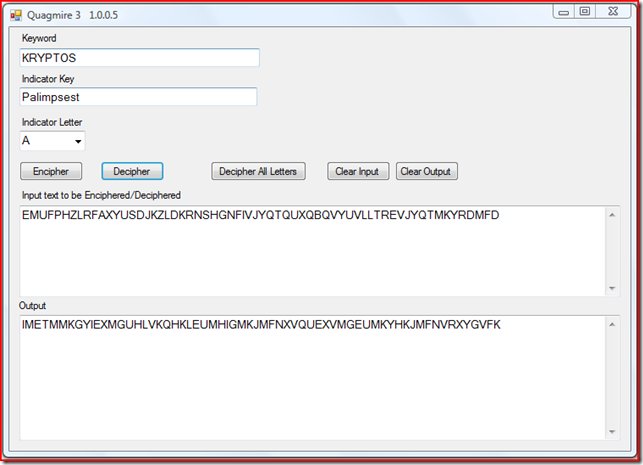
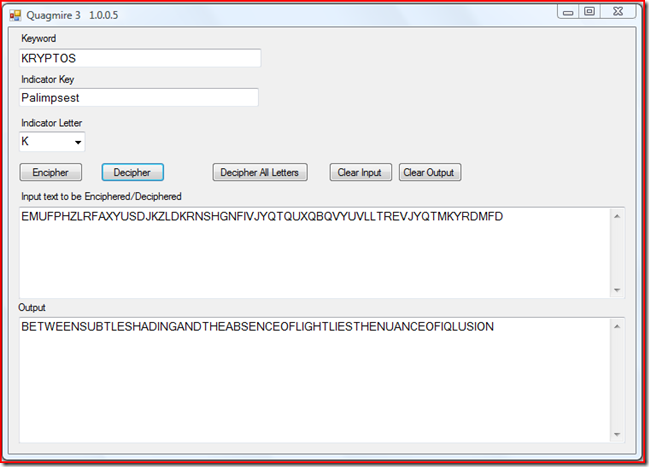


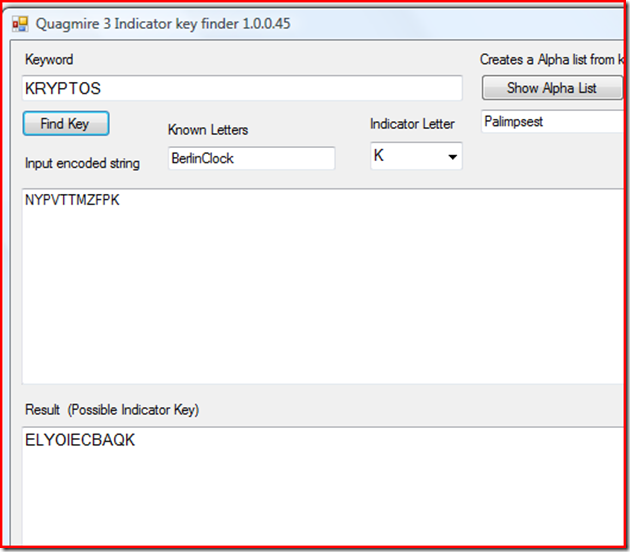




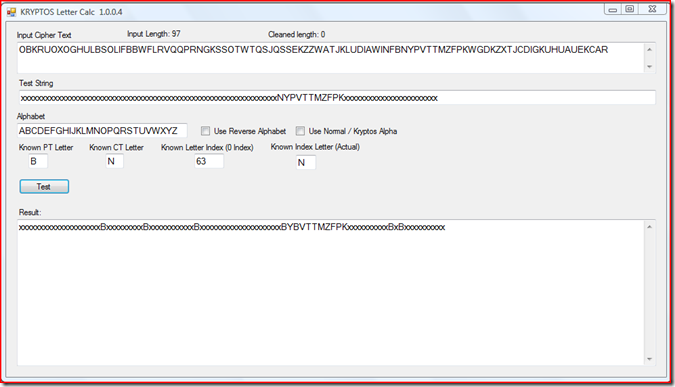
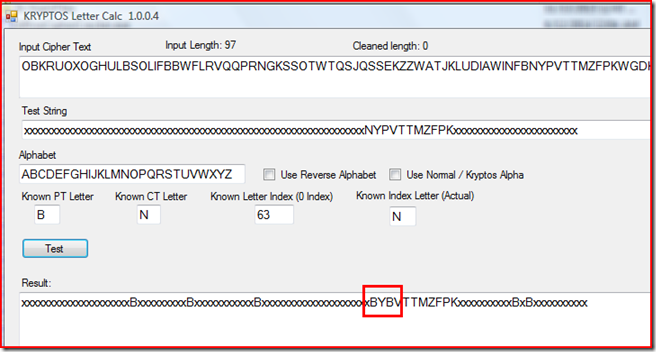


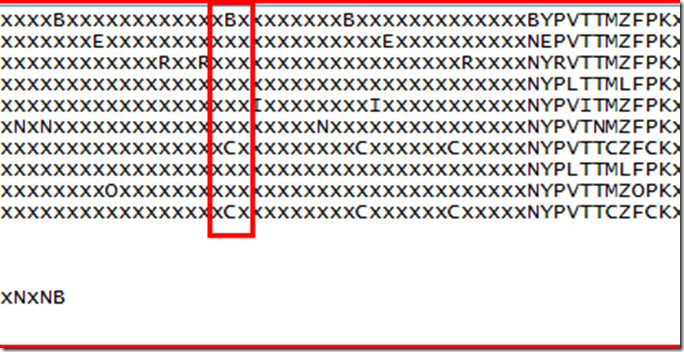


NYPVTT CIPHER
BERLIN CLEAR TEXT
QUCKLG THE KEY
MZFPKW CIPHER
CLOCKS CLEAR TEXT
KORNAE THE KEY
Using Vigenere ciphertext.
Then I believe that would mean that they used a random string for a key for every word, which would make it is more along the lines of a 1 time pad.
personally, I believe that this cipher is all the world cities as they appear on the Berlin Clock
I have been getting slight indications (using railfence cipher )
CIOEAHERTOWN could be capetown
TWEABEGAO could be tobago
DEQWIRTFSEEHEBJANEREQ could be de janeiro
TDULINW could be dublin
As I stated in the post, there were plain letters that encoded to more that one letter so it can’t be any type of Single Alphabet Cipher. I’m sure once it is fully decoded why he chose those words to reveal. It is most likely a homegrown Cipher, the reason no one has solved it or publicly revealed it.
Pingback: Ghost In The Wires Paperback Ciphers | PC's Xcetra Support